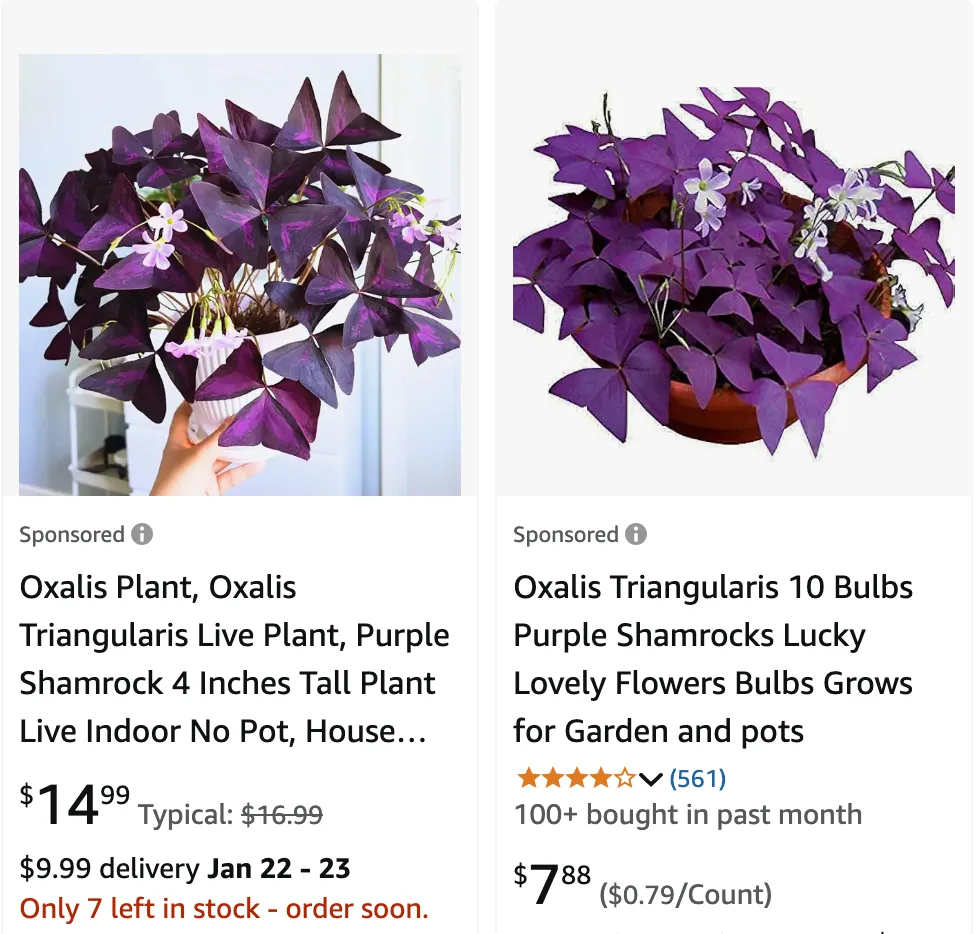
569 Species in Genus Oxalis
What is Oxalis Triangularis?
Oxalis Triangularis, commonly known as the purple shamrock, is a striking ornamental plant with vibrant purple, triangular-shaped leaves and delicate white or pale pink flowers. Native to South America, it is often used as a houseplant or outdoor accent. The leaves close at night or during low light, adding an interactive charm to its beauty.
Where to buy Oxalis Triangularis?
You can purchase Oxalis Triangularis from local garden centers, online plant shops, or even marketplaces like Etsy and Amazon. I’ve found that specialty nurseries often have healthier bulbs or plants. Always check reviews and ensure the supplier ships quality, pest-free specimens.
How to care for Oxalis Triangularis?
Caring for Oxalis Triangularis is straightforward. It thrives in bright, indirect light and prefers well-draining soil. Water when the top inch of soil feels dry, but avoid overwatering to prevent root rot. Monthly feeding with a balanced fertilizer during the growing season helps maintain its vibrancy. Keep it in temperatures between 60–75°F (15–24°C) for the best results.
How to plant Oxalis Triangularis bulbs?
To plant Oxalis Triangularis bulbs, place them in well-draining soil with the pointed side facing up, about an inch deep. Space them a few inches apart. After planting, water lightly and keep the soil moist but not soggy until you see new growth, which usually takes 2–4 weeks.
Can Oxalis Triangularis grow in water?
Yes, Oxalis Triangularis can grow in water temporarily. You can propagate it by placing cuttings in water to encourage root development. However, for long-term growth, it’s best to plant it in soil as the plant needs nutrients and support from the soil for optimal health.
Can Oxalis Triangularis grow outside?
Absolutely! Oxalis Triangularis can grow outdoors in USDA zones 6–10. It thrives in partial shade to full sun, but in hotter climates, partial shade helps prevent leaf scorch. Be mindful of frost, as the plant isn’t cold-hardy.
Can you eat Oxalis Triangularis?
Yes, you can eat Oxalis Triangularis, but in moderation. Its leaves have a tangy, lemon-like taste due to oxalic acid, which can be harmful in large quantities. Always consult with a professional before consuming if you’re unsure or have dietary restrictions.
Does Oxalis Triangularis go dormant?
Yes, Oxalis Triangularis naturally goes dormant, typically in late summer or winter. During dormancy, the leaves may wilt or die back. Reduce watering, stop fertilizing, and let the bulbs rest in dry soil until new growth begins.
Does Oxalis Triangularis spread?
Oxalis Triangularis spreads through its bulbs, gradually expanding its clump over time. While it isn’t invasive, it can fill a container or small garden bed if left undisturbed.
How to grow Oxalis Triangularis from seed?
Growing Oxalis Triangularis from seed is less common than using bulbs, but it’s possible. Sow seeds in a light, well-draining mix, cover lightly with soil, and keep the substrate consistently moist. Germination can take several weeks, so patience is key.
How to make Oxalis Triangularis bushy?
To make your Oxalis Triangularis bushier, trim off any leggy or dying stems to encourage new growth. Providing plenty of indirect sunlight and fertilizing regularly also stimulates denser foliage.
How to repot Oxalis Triangularis?
Repotting Oxalis Triangularis is simple. Choose a pot slightly larger than its current one, ensure it has good drainage, and use fresh, well-draining soil. Repot during the plant’s active growth period, usually in spring.
How to revive Oxalis Triangularis?
If your Oxalis Triangularis looks unhealthy, assess its environment. Check for overwatering, underwatering, or pests. Trim back any dying foliage, adjust its watering schedule, and place it in bright, indirect light. Often, proper care will bring it back to life.
How to propagate Oxalis Triangularis?
Propagation is easiest through division. Separate the bulbs or rhizomes during repotting and plant them in fresh soil. Water lightly until new growth emerges.
What to plant with Oxalis Triangularis?
Pair Oxalis Triangularis with plants that have contrasting textures or colors, such as ferns, white begonias, or golden pothos. These combinations create a visually striking display.
Can you grow Oxalis Triangularis indoors?
Yes, Oxalis Triangularis is an excellent indoor plant. Its vibrant leaves and low-maintenance nature make it perfect for bright windowsills or tables.
Is Oxalis Triangularis toxic?
Oxalis Triangularis is mildly toxic to pets and humans if consumed in large quantities due to oxalic acid. Keep it out of reach of curious pets or children.
What are the benefits of Oxalis Triangularis?
Besides its aesthetic appeal, Oxalis Triangularis improves indoor air quality and adds a calming touch to any space. Its unique leaf movements are also fascinating to observe.
What are common problems with Oxalis Triangularis?
Common issues include yellowing leaves (often due to overwatering), pest infestations like spider mites, and leggy growth from insufficient light. Address these issues promptly to maintain a healthy plant.
How does Oxalis Triangularis compare to other similar plants?
Oxalis Triangularis is often confused with other Oxalis species, but its purple foliage and triangular leaves set it apart. Compared to green Oxalis varieties, its vibrant color makes it a popular decorative choice.
If i die, water my plants!



